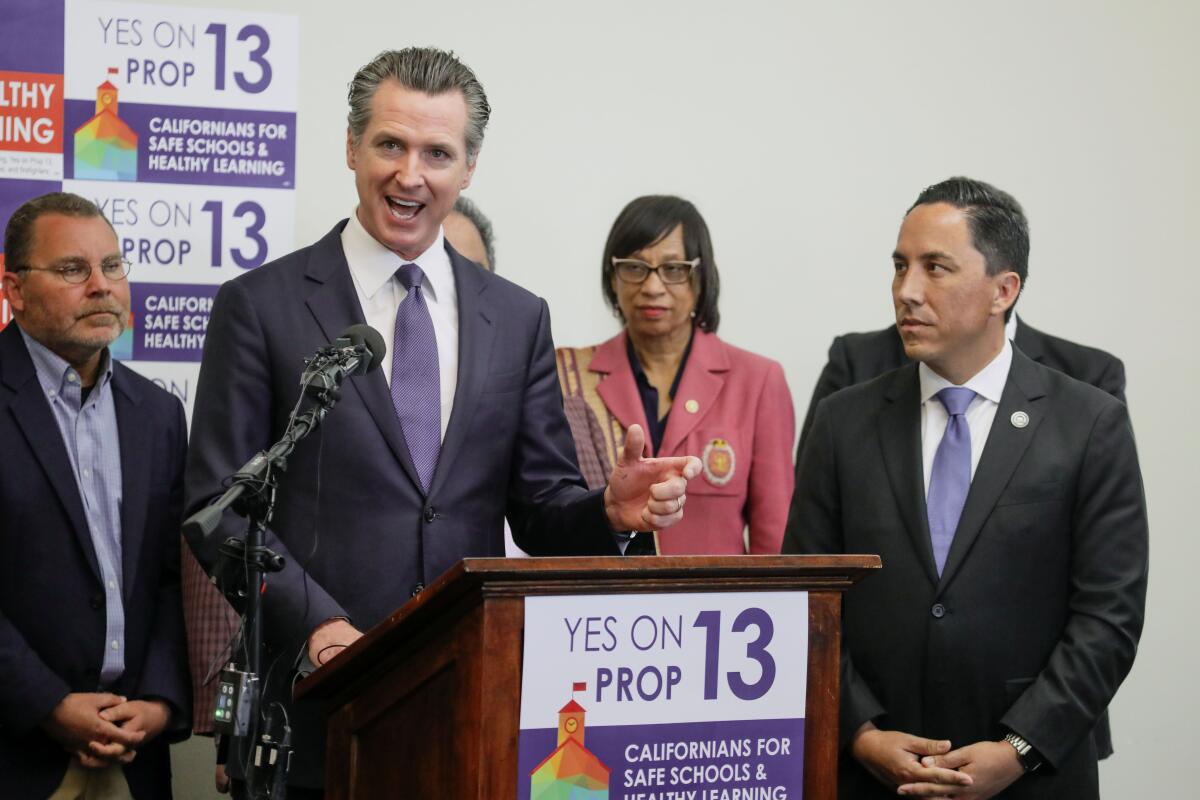Column: Proposition 13 appears headed for a fall. Here’s why voters might have rejected it

- Share via
California voters flashed a bright red stoplight at Democrats’ taxing and borrowing as they rejected the largest state school bond proposal in history.
At least it seems like voters rejected it. Stunned backers of Proposition 13 — a confusing number that probably helped dig the measure’s grave — still haven’t publicly conceded defeat. They’re clinging to slim hope that continued vote counting from Super Tuesday will yet save the measure.
By the end of last week, Proposition 13 trailed by 44.8% to 55.2%. That’s a big deficit to fill.
It has been 26 years — 1994, a very Republican election — since the last state school bond failed. Two small ones narrowly lost: $1 billion for K-12 schools and $900 million for higher education.
Regardless of Proposition 13’s final vote count, the taxing and borrowing stoplight was flashed all over California in local elections. Voters spurned an unprecedented number of local school bond issues and tax hikes.
The California Taxpayers Assn., an anti-tax lobby, reported that of 237 local tax and bond measures at stake, 58 passed and 122 failed; 57 were too close to call.
Voters passed 21 school bonds and killed 64; 36 are still undecided.
By contrast, in the 2016 presidential primary 67 local tax and bond measures passed and only 20 failed.
Passage of a local school bond requires a 55% vote; a state bond only a simple majority. A local tax hike generally needs a two-thirds vote.
Proposition 13 would not have raised taxes directly. But it inevitably would have led to local proposals for higher property levies. That’s because the cap on the amount of bonds that school districts could issue would be nearly doubled. And that surely would have resulted in districts asking voters for higher property taxes to pay off the bonds.
The proposition would have authorized a record $15 billion in school construction bonds — $9 billion for K-12 and $2 billion each for community colleges, state universities and the University of California.
Many voters probably noticed in the Secretary of State’s official information guide that interest on the bonds would cost $11 billion, bringing the total tab to $26 billion. Paying off the bonds would jack up state spending by $740 million annually for 35 years. And the state is already spending $6 billion a year to retire almost $80 billion in various bonds.
Sudden jitters concerning the economy caused by a plunging stock market attributed to the coronavirus threat probably prompted some hesitation by voters about the state going deeper into debt. More debt in a slumping economy could require higher taxes.
A recent “Political Geography” study by the nonpartisan Public Policy Institute of California found widespread belief by people that they are overtaxed in this state. The research was based on several PPIC polls.
“Most Californians from coast to interior feel their taxes are too high,” the report read. “Overall, 58% hold this opinion.”
“There’s not overwhelming support in the state for big government programs that Democrats support,” the report’s author, PPIC senior fellow Eric McGhee, told me. “The feeling that taxes are too high is pretty universal — state and local taxes.”
“People are cynical about how the money is being spent,” says Susan Shelley, vice president of the Howard Jarvis Taxpayers Assn. “Maybe the message is ‘enough is enough.’
“Confusion over Proposition 13 is not the whole story here.”
Howard Jarvis was the apartment owners’ lobbyist who launched the original Proposition 13, the historic 1978 ballot initiative that substantially limited property tax increases and ignited a nationwide anti-tax revolt.
Many voters mistakenly suspected that the school bond 13 was an attempt to repeal or undermine the original 13. This confusion was fueled by the fact that a teachers’ union-backed initiative to eliminate tax protections for commercial and industrial properties is headed for the November ballot. It would be the first major amendment of the tax-cutting 13 — and now seems in serious jeopardy based on voters’ rejection of higher taxes and borrowing.
“When people are confused, they tend to vote ‘no,’” says Assemblyman Patrick O’Donnell (D-Long Beach), coauthor of the school bond. He intends to introduce legislation to retire “13” as a proposition number, just as professional sports teams retire their superstars’ jersey numbers.
“I’m going to retire the number so no one else has to go through this,” O’Donnell says.
But PPIC pollster and President Mark Baldassare says, “I don’t buy the Prop. 13 confusion. We saw weakness all along in this measure. It’s always easy to say it was confusion — something else’s fault.
“A case needed to be made to the voters and it was never made.
“I also wonder whether something bigger is going on here about how people are feeling about school funding.”
They clearly are feeling skeptical about it.
It was Gov. Gavin Newsom’s job to make the case for Proposition 13. He crafted the final product, combining two legislative bond proposals — one for K-12, another for universities — and increasing the total dollar amount.
The governor also added a few complexities and controversies. Some cost him the support of the Los Angeles Unified School District. He changed the formula for disbursing bond money to districts, gave preference to projects using union labor, reduced developer fees and raised the local cap on borrowing.
Newsom owned the bond measure and couldn’t sell it. His political team spent more than $10 million trying.
The Jarvis outfit dug up a mere $250,000 for opposition radio ads — and a red stoplight.
More to Read
Sign up for Essential California
The most important California stories and recommendations in your inbox every morning.
You may occasionally receive promotional content from the Los Angeles Times.











